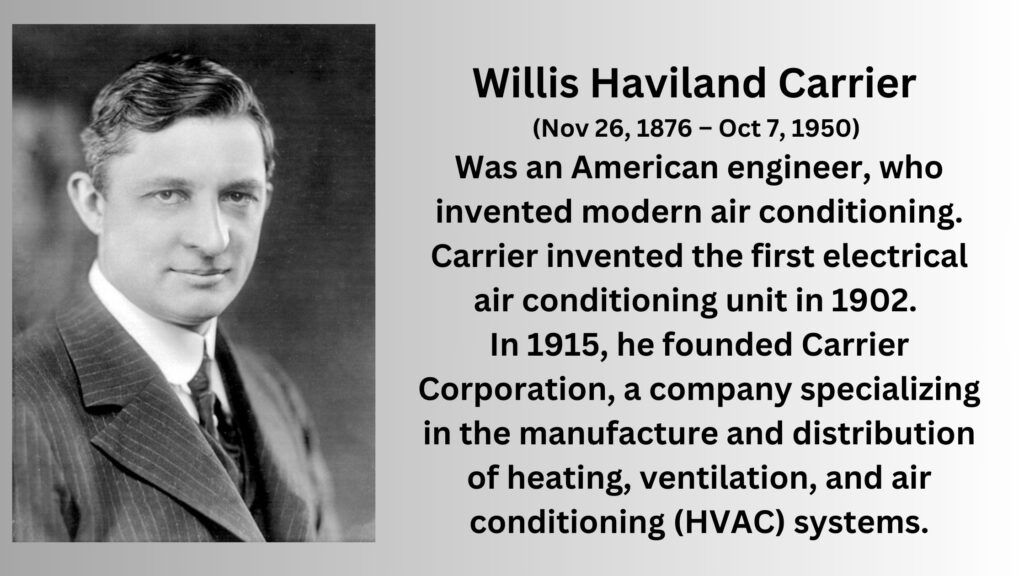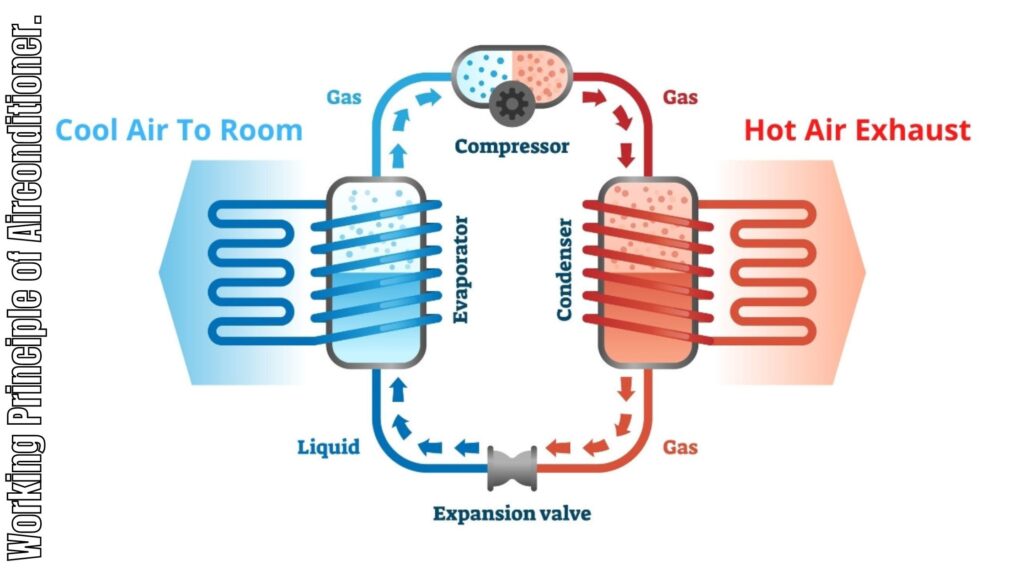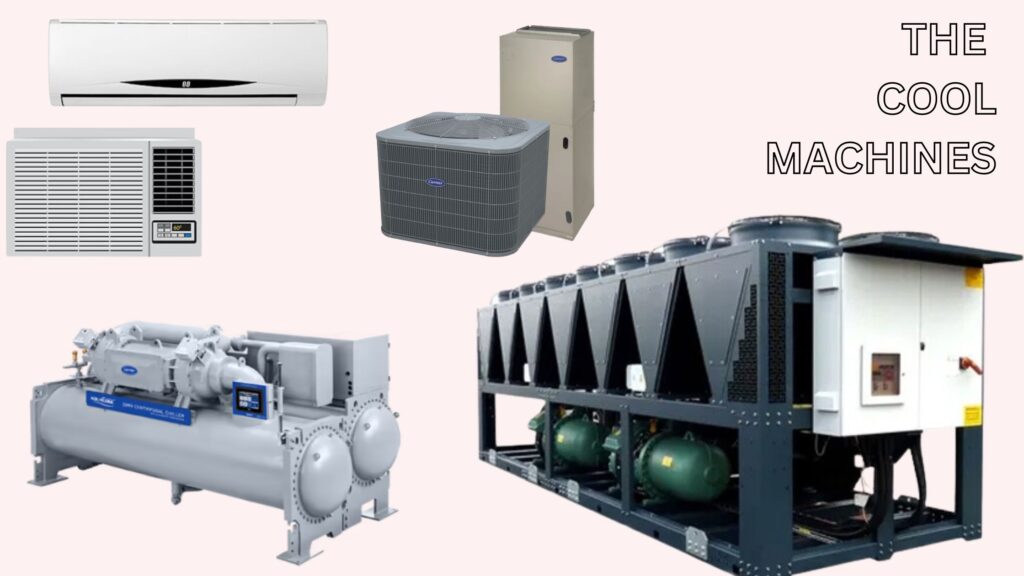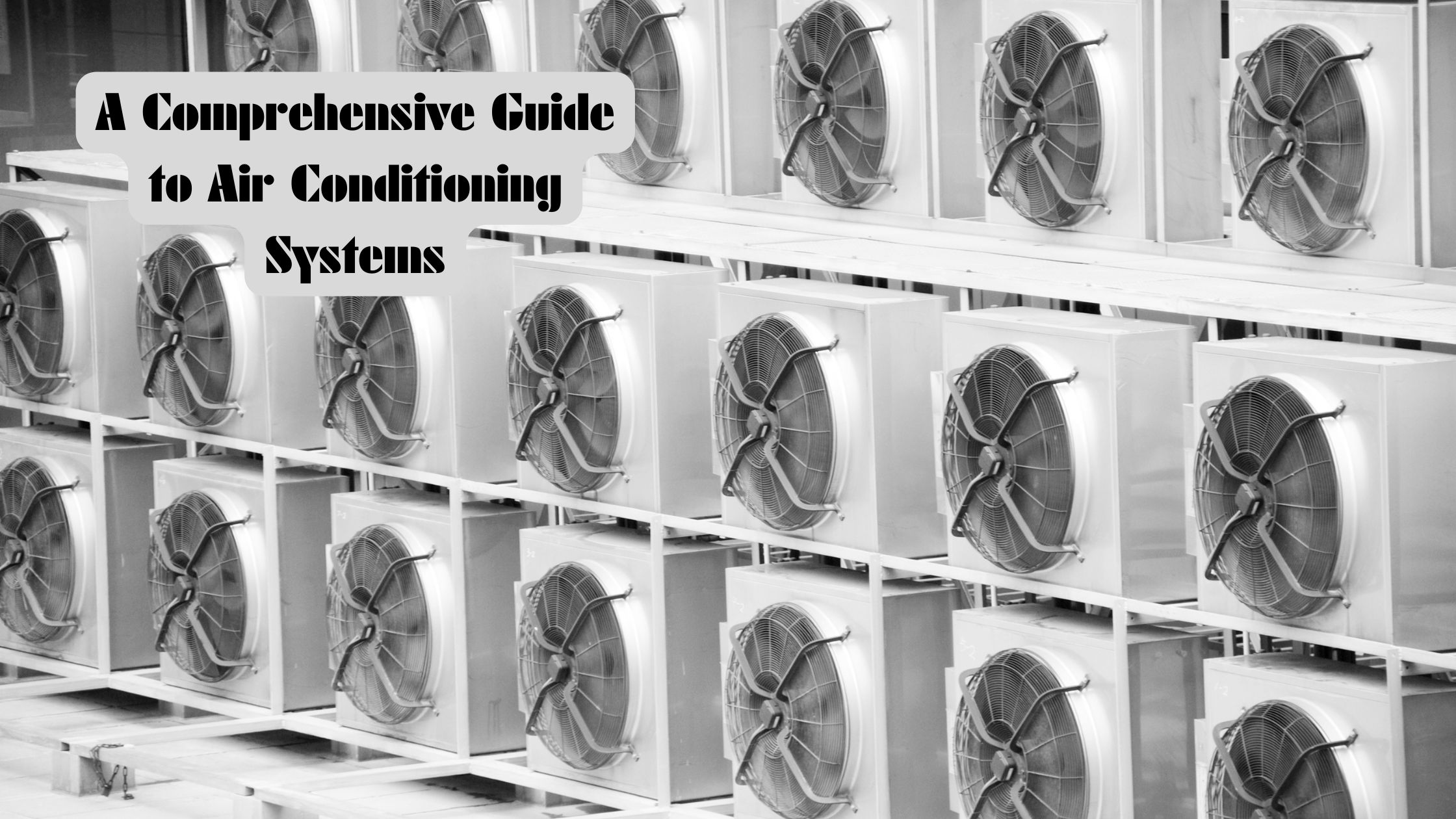Introduction to Air Conditioners: Definition and purpose of air conditioners
Air conditioning (AC) systems are a crucial part of modern living environments, providing thermal comfort and acceptable indoor air quality. The primary function of air conditioners is to alter the properties of air (primarily temperature and humidity) to more comfortable conditions. Here’s an in-depth look at the definition and purposes of air conditioners.
Definition:
Air conditioners are systems or machines that treat air in enclosed areas via a refrigeration cycle, where warm air is removed and replaced with cooler and more humid air. The core components of an AC system include a compressor, a condenser, and an evaporator, working in harmony to carry out the process of cooling the air. The refrigeration cycle involves the conversion of a refrigerant substance from a gas to a liquid and back again, absorbing and releasing heat in the process.
Purpose:
Temperature Control: The primary purpose of air conditioners is to maintain a comfortable indoor temperature. During hot weather, AC systems provide a cool indoor environment, which is crucial for comfort, especially in humid and tropical regions.
Humidity Control: Air conditioners also manage the humidity level within an enclosed space. By drawing moisture from the indoor air, they create a more comfortable environment and prevent issues like mold growth.
Air Quality Improvement: Many air conditioning systems are equipped with filters that clean the indoor air by trapping dust, pollen, and other allergens. This feature is essential for individuals with allergies or respiratory issues.
Health and Comfort: By providing a cool and comfortable indoor environment, air conditioners contribute to better physical and mental well-being. They help in preventing heat-related illnesses and improve comfort, which, in turn, enhances productivity and mood.
Preservation of Items: Air conditioners help in preserving the quality and lifespan of household items. High temperatures and humidity can cause damage to furniture, electronics, and other valuables.
Industrial Applications: In industrial settings, air conditioning is essential for maintaining a controlled environment, which is crucial for the quality and safety of products. For instance, in the pharmaceutical and food industries, precise temperature and humidity control are imperative to meet regulatory and quality standards.
Technological and Economic Development: Air conditioning technology has played a significant role in enabling economic development, especially in hot, humid regions. It has also facilitated advancements in technology and medicine by providing the necessary controlled environments.
Ventilation: Besides cooling, AC systems often have ventilation features that help in circulating and refreshing the indoor air, contributing to a healthier and more pleasant environment.
The advent and widespread adoption of air conditioning systems have significantly impacted modern living and working environments. Their ability to provide thermal comfort, improve air quality, and maintain controlled conditions for industrial processes underlines their importance in contemporary society. Through continuous technological advancements, modern air conditioning systems are becoming more energy-efficient and environmentally friendly, addressing some of the environmental concerns associated with their usage.
Historical background of air conditioning technology

Above Picture and information credit to : https://en.wikipedia.org/wiki/Willis_Carrier
The history of air conditioning technology is a fascinating journey that reflects humanity’s enduring quest for comfort and better living conditions. Over centuries, various cooling methods have been devised to combat heat. However, modern air conditioning has a relatively short history, with its roots traced back to the early 20th century.
Early Cooling Methods: Before the invention of modern air conditioning, ancient civilizations employed various techniques to keep cool. For instance, the ancient Egyptians used wet reeds in windows to cool indoor air with evaporating water. In ancient Rome, water from aqueducts was circulated through walls to cool buildings.
19th Century Ventures: In the 19th century, scientists and inventors began exploring mechanical methods for cooling. In 1842, Dr. John Gorrie, an American physician, created a machine to cool hospital rooms using compressed air. Although his invention didn’t gain commercial traction, it laid the groundwork for future developments in mechanical cooling.
Willis Carrier and the Birth of Modern Air Conditioning: The birth of modern air conditioning is attributed to Willis Carrier, an American engineer. In 1902, while working at a publishing company in Brooklyn, he designed a system to control humidity using cooling coils, marking the invention of the first electrical air conditioning unit. Carrier’s invention not only cooled the air but also controlled humidity, making it a significant advancement over previous cooling methods.
Expansion and Commercialization: Carrier’s invention spurred further developments and commercialization of air conditioning technology. In the 1920s, the technology was introduced to movie theaters, making the cinema a popular escape from the summer heat. By the 1930s, air conditioning began appearing in residential homes, although widespread adoption was slow due to the cost.
Post World War II Boom: The period following World War II saw a boom in air conditioning sales, thanks to economic prosperity and advancements in technology that made units more affordable and efficient. This period marked the beginning of widespread residential and commercial use of air conditioning, significantly impacting architectural designs and enabling economic development in warmer climates.
Technological Advancements and Environmental Awareness: Over the decades, air conditioning technology has seen continuous improvements aimed at enhancing efficiency, reducing energy consumption, and minimizing environmental impact. The 1970s oil crisis, for instance, spurred the development of more energy-efficient systems. In recent years, concerns over the environmental impact of refrigerants used in air conditioning systems have led to the adoption of more eco-friendly alternatives.
The Current State and Future Trends: Today, air conditioning is an integral part of modern living, especially in urban areas and warmer climates. The technology continues to evolve, with trends pointing towards smart, energy-efficient systems, integrated with other smart home technologies, and using eco-friendly refrigerants.
Air conditioning technology has come a long way since its inception. From simple evaporative cooling methods employed by ancient civilizations to the sophisticated, energy-efficient systems of today, the evolution of air conditioning reflects the human endeavor for enhanced comfort and improved living conditions. As we move forward, the focus is increasingly on developing sustainable and energy-efficient air conditioning solutions to cater to the growing global demand while minimizing environmental impact.
Working Principle of Airconditioner.

Air conditioners are designed to maintain a specified temperature in a space by removing heat from the indoor environment and releasing it outside. Here’s a simplified breakdown of how they operate:
Thermal Exchange:
When the air conditioner is turned on, the thermostat senses the room temperature and sends a signal to start the cooling process if the room temperature is higher than the set point.
The core of this process lies in a special liquid called refrigerant, which has the ability to easily change from a liquid to a gas and back again, enabling the absorption and release of heat.
Evaporation:
Inside the indoor unit of the air conditioner, the refrigerant flows through a series of coils known as the evaporator coils.
As warm indoor air blows across these coils, the refrigerant inside absorbs the heat, causing it to evaporate into a gas. This process significantly cools the air, which is then circulated back into the room by a fan.
Compression and Condensation:
The refrigerant gas, now carrying the absorbed heat, travels to the outdoor unit where it enters a compressor.
The compressor compresses the refrigerant gas, increasing its temperature and pressure.
This high-pressure, high-temperature gas then flows through another set of coils known as the condenser coils. As outdoor air is blown across these coils, the heat from the refrigerant is transferred to the outside air, and the refrigerant condenses back into a liquid state.
Expansion:
The liquid refrigerant travels back to the indoor unit, passing through an expansion valve that reduces its pressure, preparing it for the evaporation process again.
Repetition:
The cycle repeats until the indoor temperature reaches the desired level as set on the thermostat, at which point the air conditioner shuts off. When the temperature rises again, the thermostat triggers the air conditioner to start the cycle anew.
Dehumidification and Filtration:
Besides cooling, air conditioners also dehumidify the air by condensing moisture on the cold coils of the evaporator, which is then drained away.
They also have filters to clean the air from dust, allergens, and other particulate matter, contributing to better air quality indoors.
This process of cycling the refrigerant to transfer heat from indoors to outdoors, while also dehumidifying and filtering the air, enables air conditioners to maintain a comfortable, clean indoor environment.
Components and Their Functions
Compressor:
The compressor is essentially the heart of the air conditioning system, playing a vital role in the refrigeration cycle. It’s located in the outdoor unit of the air conditioner.
Here’s how it operates:
- The compressor receives low-pressure refrigerant gas from the evaporator coil.
- It compresses the refrigerant gas, turning it into a high-pressure, high-temperature gas.
- This process also propels the refrigerant into the condenser coil.
- The energy used by the compressor to compress the refrigerant contributes to its increased temperature.
Condenser Coil:
Located in the outdoor unit along with the compressor, the condenser coil is crucial for heat dissipation.
Here’s what happens in the condenser coil:
- The high-pressure, high-temperature refrigerant gas enters the condenser coil from the compressor.
- As the refrigerant flows through the coils, it encounters outdoor air being blown across the coils by a fan.
- The heat from the refrigerant is transferred to the outdoor air, causing the refrigerant to condense into a liquid.
- This liquid refrigerant, now at a lower temperature but still at high pressure, is then directed towards the expansion valve.
Expansion Valve:
The expansion valve acts as a regulator between the high-pressure and low-pressure sides of the system.
Here’s its role:
- The high-pressure liquid refrigerant from the condenser coil reaches the expansion valve.
- The expansion valve reduces the pressure of the liquid refrigerant drastically as it passes through.
- This process also controls the flow rate of the refrigerant into the evaporator coil, ensuring the right amount enters the coil for effective cooling.
Evaporator Coil:
Situated in the indoor unit, the evaporator coil is where the actual cooling happens.
Here’s how:
- The low-pressure liquid refrigerant enters the evaporator coil from the expansion valve.
- As indoor air is blown over the coils by a fan, the refrigerant absorbs the heat from the air.
- This process causes the refrigerant to evaporate into a gas again, significantly lowering the temperature of the air.
- This cool air is then circulated back into the room, while the refrigerant gas heads back to the compressor to repeat the cycle.
These components work in a continuous cycle, ensuring a consistent temperature is maintained in the indoor environment. Each part is indispensable and contributes to the efficient functioning of the air conditioning system, making the process of cooling possible and efficient.
Discovering the Array of Air Conditioning Systems

Air conditioning systems come in a variety of designs to cater to different spaces and requirements. Here’s a breakdown of types of air conditioners suitable for residential buildings and industrial applications:
Window Air Conditioners:
Window air conditioners are compact, self-contained units designed for cooling single rooms. Typically installed in a window or wall opening, they house all essential components like the compressor, condenser, evaporator, and expansion valve within one unit. Known for their ease of installation and affordability, they are ideal for cooling smaller spaces. These units work by expelling warm air outside while cooling the interior. They come in various cooling capacities to suit different room sizes. However, they may be less energy-efficient compared to central or split systems, and their cooling capacity is generally limited to the room in which they are installed, making them a popular choice for those seeking a cost-effective and straightforward cooling solution.
Split Air Conditioners (Ductless):
Split air conditioners, also known as ductless air conditioners, consist of two main components: an outdoor unit housing the compressor and condenser, and an indoor unit containing the evaporator and fan. Unlike traditional central air conditioners, they don’t require ductwork, making them more energy-efficient and easier to install. The indoor and outdoor units are connected by a conduit housing the power cable, refrigerant tubing, and a condensate drain, allowing for flexible placement. Split air conditioners offer the advantage of cooling individual rooms to different temperatures, promoting better climate control and potentially lower electricity bills. They are ideal for cooling specific areas or rooms in a house, and their sleek design allows for a more aesthetic and less obtrusive installation compared to window units.
Central Air Conditioners:
Central air conditioners circulate cool air through a system of supply and return ducts, ensuring a consistent temperature throughout a home or building. They consist of an outdoor unit housing the compressor and condenser, and an indoor unit with the evaporator, usually installed alongside a furnace or air handler to circulate the cooled air. These systems are efficient for cooling large spaces and multiple rooms simultaneously. The installation of central air conditioners involves complex ductwork, making the initial setup more intricate and costly compared to other types. However, once installed, they operate quietly and are visually unobtrusive. Central air conditioners also contribute to improved air quality by filtering airborne pollutants and maintaining optimal humidity levels, providing a comfortable indoor environment.
Portable Air Conditioners:
Portable air conditioners are mobile units designed for cooling individual rooms. They are easy to install, requiring only an electrical outlet and a window for the exhaust hose. These units extract warm air from the room, cool it internally, and return the cooled air back into the room, expelling the warm air outside through the exhaust hose. They come with various cooling capacities, making them suitable for different room sizes. Although less energy-efficient compared to central or split systems, their mobility allows for a flexible cooling solution, especially in rented spaces or areas where permanent installation isn’t feasible. They also offer additional features like dehumidification, air purification, and heating capabilities, making them a versatile choice for maintaining a comfortable indoor environment.
Hybrid Air Conditioners:
Hybrid air conditioners, as the name suggests, are a combination of traditional air conditioning technology and alternative, energy-saving methods. These systems typically combine a standard electrically-driven compressor with a gas engine or a heat pump, allowing them to switch between electricity and fossil fuels to optimize energy usage and reduce costs. During warmer months, they function like a traditional air conditioner, utilizing electricity to cool your home. When the weather is cooler, they can switch to a heat pump mode to harness external heat to warm the indoor space, offering a more energy-efficient heating solution. The intelligent switching between the two modes based on temperature conditions helps in reducing electricity consumption, making hybrid air conditioners an eco-friendly and cost-effective choice for varying climates.
Geothermal Air Conditioners:
Geothermal air conditioners are an eco-friendly cooling solution that leverage the earth’s constant underground temperature to cool or heat a space. These systems circulate a water-based solution through a loop of underground pipes where it absorbs the earth’s stable temperature. In cooling mode, the system extracts heat from indoors and transfers it to the ground loop, from where it’s dissipated into the earth. Conversely, in heating mode, the process is reversed, and the system extracts heat from the ground to warm the indoor space. Geothermal air conditioners are highly energy-efficient, reducing electricity consumption and thereby lowering energy bills. Despite the high upfront installation cost due to the need for underground piping, the long-term savings and environmental benefits make geothermal air conditioning a sustainable choice for temperature regulation.
Packaged Air Conditioners:
Packaged air conditioners are self-contained cooling systems ideal for larger spaces or multiple rooms. Unlike split systems where components are separated, packaged units house the compressor, condenser, evaporator, and other essential components in a single casing. Typically, they are installed on rooftops or near the foundation on the ground level, and cool air is distributed through ductwork. They come in various capacities to meet different cooling demands, and some models offer heating capabilities as well, providing a versatile climate control solution. Packaged air conditioners are known for their efficiency and ease of installation, with a compact design that saves space and simplifies maintenance. They are a popular choice for commercial buildings, small industries, or homes in regions with moderate cooling and heating needs, providing a streamlined approach to indoor climate control.
Roof Top Units (RTUs):
Rooftop Units (RTUs) are a type of HVAC system installed on the roof of commercial buildings or large residences to provide centralized heating, cooling, and ventilation. They are self-contained units housing all necessary components like the compressor, condenser, evaporator, and fan in one casing. The placement on the roof saves indoor space, reduces noise, and allows for efficient air distribution through ductwork extending from the unit into the building. RTUs are designed to cool or heat large spaces and can handle high cooling loads, making them ideal for commercial or industrial applications. They come in a variety of sizes and capacities to meet different climate control needs. Their modular design also allows for easy expansion or upgrading, making them a flexible and convenient choice for maintaining a comfortable indoor environment in larger spaces.
Chillers:
Chillers are a type of cooling system that remove heat from a liquid, which can then be circulated through a heat exchanger to cool air or equipment. There are two primary types of chillers: air-cooled and water-cooled. Each has its unique set of features, advantages, and disadvantages.
Air-Cooled Chillers:
Air-cooled chillers rely on a condenser cooled by the ambient air to expel heat. They have condenser coils cooled by fan-driven air. These chillers are generally used in applications where the additional heat they discharge is not a factor. They are simpler and less expensive to install and maintain compared to water-cooled chillers. However, they tend to be less energy-efficient and might not be suitable for high-temperature environments where the ambient air is too warm to provide adequate cooling. Air-cooled chillers are often preferred for small or medium installations where simplicity and cost are key considerations.
Water-Cooled Chillers:
Water-cooled chillers, on the other hand, use water or another liquid to absorb and remove heat. They have a water-cooled condenser connected with cooling towers to expel the heat to the atmosphere. These chillers are more efficient and effective in maintaining the desired temperature compared to air-cooled chillers, especially in high-temperature or high-humidity environments. They are typically used in medium to large installations where better efficiency and cooling performance are required. However, they are more complex, requiring a cooling tower and a water pump, thus leading to higher installation and maintenance costs. The continuous water supply and treatment to prevent scaling and corrosion are other considerations for their operation.
Variable Refrigerant Flow (VRF) Systems:
Variable Refrigerant Flow (VRF) systems are advanced air conditioning systems known for their high energy efficiency and flexibility in controlling the indoor climate. They use refrigerant as the cooling and heating medium, and their defining feature is the ability to control the amount of refrigerant flowing to multiple evaporators (indoor units), allowing for individualized comfort control in different zones or rooms, all from a single outdoor unit. VRF systems can simultaneously heat and cool different areas, optimizing energy consumption by reusing heat from cooling areas to warm others. They are suitable for a variety of settings, including commercial buildings, hotels, and large residences, where different temperature settings are desired. Their modular design, quiet operation, and energy-saving features make VRF systems a popular choice for modern, efficient climate control solutions.
Evaporative Coolers:
Evaporative coolers, also known as swamp coolers, provide cooling through the natural process of water evaporation. They draw warm air through water-saturated pads where the air is cooled by evaporation before being circulated into the living space. These coolers are energy-efficient and eco-friendly, using only water and a fan to provide cooling, making them a cost-effective alternative to traditional air conditioning systems. They work best in dry, arid climates where the evaporation process is more effective, and can also add moisture to the air, which can be beneficial in such dry conditions. However, their cooling capability is limited compared to other air conditioning systems, and they may not be effective in humid climates where the air is already saturated with moisture. Nonetheless, evaporative coolers are a simple and sustainable solution for cooling needs in suitable climates.
District Cooling
District cooling is a centralized cooling system where chilled water is produced at a central plant and distributed through a network of insulated underground pipes to multiple buildings in a district or area. This system eliminates the need for individual cooling units in each building, leading to more efficient energy usage and lower maintenance costs. The central plant utilizes chillers, often driven by electricity or natural gas, to chill the water which then absorbs heat from the buildings before returning to the plant to be re-chilled. District cooling is a more environmentally friendly and efficient solution for cooling large urban areas or complexes, reducing greenhouse gas emissions and decreasing the load on the electrical grid. By centralizing the cooling infrastructure, district cooling facilitates better control, maintenance, and optimization of the cooling process across a broader area.
Each type of air conditioner has its own set of advantages, limitations, and suitable applications. The choice between them would depend on the specific cooling needs, the size and nature of the space, budget constraints, and energy efficiency considerations.
Importance of Air conditioners

In modern living and working environments, air conditioning plays a pivotal role in ensuring comfort and promoting productivity. By maintaining a cool and pleasant indoor temperature during sweltering summer months, air conditioners create conducive environments for relaxation, work, and sleep. Moreover, they significantly improve air quality by filtering out pollutants, allergens, and other particulate matter, promoting better health and well-being. In commercial and industrial settings, air conditioning is crucial not only for the comfort of the occupants but also for the optimal operation of equipment and machinery. Certain equipment require a controlled temperature to function properly and to ensure longevity. Furthermore, in sectors like retail, the hospitality industry, and data centers, air conditioning is indispensable for preserving the quality of products, ensuring customer satisfaction, and safeguarding critical data. Overall, air conditioning is not a luxury but a necessity in today’s world, underpinning the smooth functioning of households, businesses, and industries.
Frequently Asked Questions
What is the side effects of AC ?
Air conditioners, while providing comfort in hot weather, can have some side effects. Continuous exposure can lead to dry skin and irritation due to the dry air. Poorly maintained systems can circulate bacteria and allergens, potentially triggering respiratory issues like asthma. Additionally, air conditioners can contribute to indoor air pollution if filters aren’t regularly cleaned or replaced. High energy consumption leading to increased electricity bills is another downside, along with the environmental impact from greenhouse gas emissions. Overuse of air conditioning can also reduce the body’s natural tolerance to heat. It’s crucial to ensure regular maintenance and proper settings to minimize these adverse effects and promote a healthier indoor environment.
What is HVAC full form?
HVAC stands for Heating, Ventilation, and Air Conditioning. It’s a comprehensive system used in both residential and commercial buildings to provide a comfortable indoor environment. The “Heating” part ensures warmth during cold weather, “Ventilation” aids in maintaining good air quality by exchanging indoor air with fresh outdoor air, and “Air Conditioning” provides cooling and humidity control. HVAC systems are crucial for creating comfortable and safe indoor environments by regulating temperature and air quality, which in turn contributes to the overall well-being and productivity of the occupants. Through a well-maintained HVAC system, individuals can enjoy a comfortable living and working atmosphere year-round.
Which gas is used in AC?
Air conditioners use refrigerant gases to absorb heat from the indoor environment and release it outdoors, thus cooling the indoor space. The most common refrigerant used historically was R-22 (Freon), but due to its harmful effects on the ozone layer, it’s being phased out. The modern and more eco-friendly refrigerants include R-410A (Puron) and R-32, which have a lower Global Warming Potential (GWP) and are better for the environment. These gases circulate within the air conditioner’s components, changing from liquid to gas and back to liquid, absorbing and releasing heat in the process. The transition towards more environmentally friendly refrigerants is a significant step in reducing the carbon footprint of air conditioning systems.
How to use air conditioner?
Utilizing air conditioning efficiently is crucial not only for ensuring a comfortable indoor environment but also for reducing energy consumption and lowering electricity bills. Here are some tips on how to use your air conditioner effectively:
- Maintain a comfortable temperature, ideally between 24°C to 26°C.
- Install a programmable thermostat to automatically adjust the temperature setting.
- Regular maintenance like cleaning or replacing filters, checking for refrigerant leaks..
- Use ceiling fans in conjunction with AC to circulate cooled air more effectively.
- Seal any gaps in doors and windows to prevent cool air from escaping.
- Try to avoid activities that generate a lot of heat.
- Use curtains, blinds, or shades to block out the sun and keep your space cool.
- If possible, upgrade to a more energy-efficient air conditioner with a higher SEER (Seasonal Energy Efficiency Ratio) rating.
What is the 3 most important factors for an AC unit ?
The three most crucial factors for an air conditioner unit include:
Cooling Capacity: Measured in British Thermal Units (BTUs), the cooling capacity denotes the amount of heat an AC unit can remove from a space in an hour. A higher BTU rating indicates a stronger cooling capacity, essential for larger spaces.
Energy Efficiency:The energy efficiency of an AC is often represented by its Seasonal Energy Efficiency Ratio (SEER) rating. Higher SEER ratings signify better energy efficiency, which translates to lower electricity bills while maintaining a comfortable temperature.
Maintenance and Durability:Easy maintenance and durability ensure the AC unit operates optimally over time. Regular maintenance like filter cleaning/replacement and ensuring a robust build quality contribute to the longevity and efficient performance of the air conditioner, making it cost-effective in the long run.


[…] These include areas such as fire safety, plumbing, structural integrity, elevator maintenance and HVAC systems. It’s the backbone of any organization as it ensures that the core facilities are operating as […]
[…] HVAC technology is a hallmark of modern facilities, ensuring energy efficiency and a pleasant […]
[…] maintenance of air conditioners (ACs) is crucial for several reasons. It ensures the efficient operation of the HVAC system, contributing […]